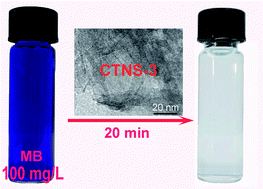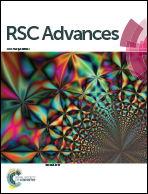One-step preparation of CdS-modified mesoporous titanate nanobelts and their application as high-performance cationic dye adsorbents†
Abstract
CdS-modified mesoporous titanate nanobelts (CTNS) were prepared successfully by one step, using TiO2 nanobelts and CdS quantum dots, and applied as an adsorbent for the first time for the removal of typical cationic dyes. The exceptionally high adsorption performance for cationic dyes is exhibited by sample CTNS-3 with a typical mesoporous structure. Its adsorption capacity for methylene blue (MB) and neutral red (NR) could reach 2444.9 mg g−1 and 3741.8 mg g−1 respectively, which is extraordinary more than the other reported adsorbents, and the corresponding adsorption yields are also very high. The equilibrium absorption capacities of both MB and NR are very high no matter if the solution is acidic, neutral or alkaline, suggesting a great application prospect for CTNS-3 in removing cationic dyes. The adsorption kinetics and mechanism are also studied. The results indicate that the whole adsorption process of MB on CTNS-3 is attributed to the Freundlich adsorption model. The second-order kinetic model conforms to the actual adsorption process of MB. The adsorption process follows the intra-particle diffusion model along with the existence of other adsorption types, such as chemical adsorption.


 Please wait while we load your content...
Please wait while we load your content...